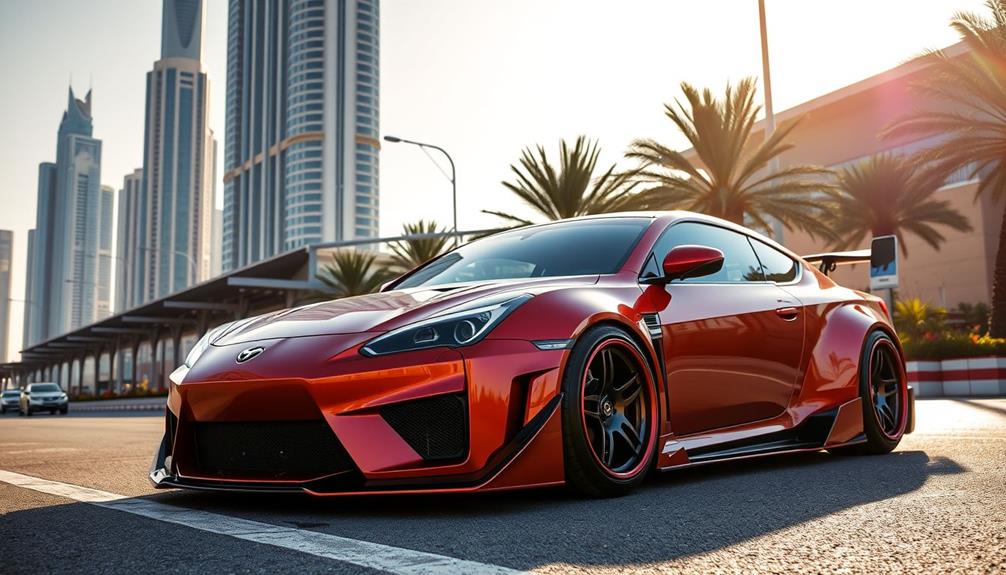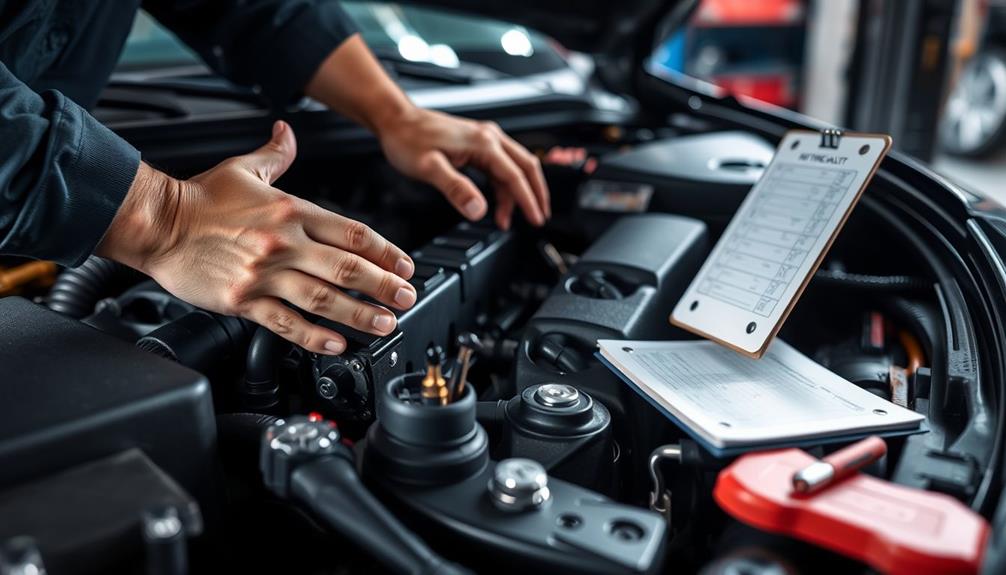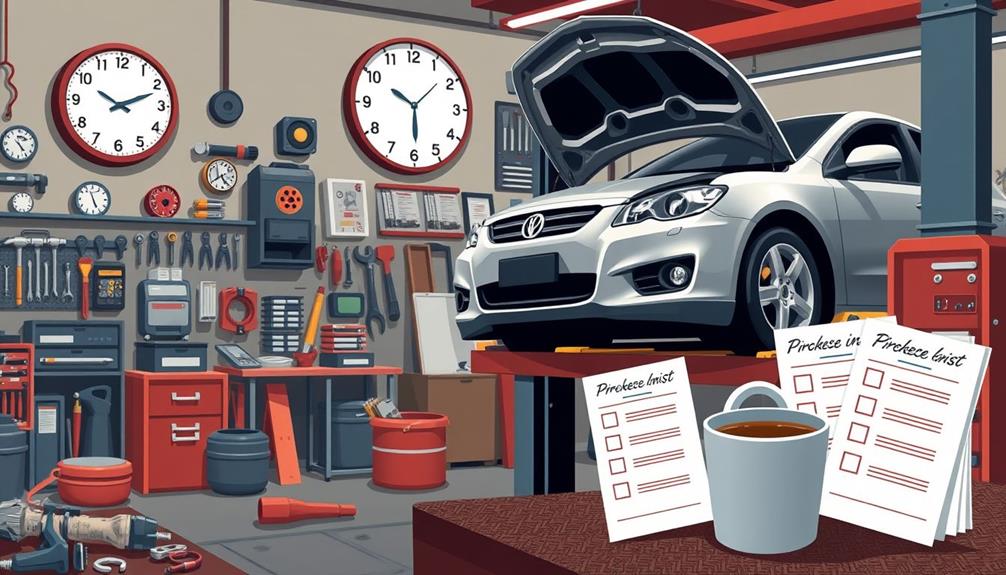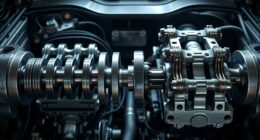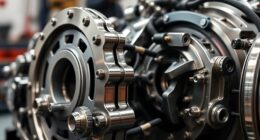Upgrading your car’s intercooler can considerably boost performance, lower intake temps, and improve boost stability. Start by understanding whether an air-to-air or water-to-air intercooler suits your setup, then consider size, material, and design for ideal cooling. Installing a front-mount intercooler offers better airflow and heat dissipation, but make certain of proper fitment and secure connections. Monitoring intake temps after install helps fine-tune your system for maximum gains—continue your journey for detailed tips and techniques.
Key Takeaways
- Understand the different types of intercoolers (air-to-air vs. air-to-water) and select based on your performance goals and budget.
- Choose a larger, high-quality front-mount intercooler with suitable materials like aluminum for better cooling efficiency.
- Properly install the intercooler, ensuring correct piping, secure fittings, and adequate clearance to prevent leaks and damage.
- Monitor intake air temperatures using gauges to optimize intercooler performance and prevent heat soak during high-load conditions.
- Maintain your intercooler regularly by cleaning debris, inspecting for leaks, and repairing damage to sustain optimal cooling and power gains.
Understanding the Role of the Intercooler in Your Vehicle

The intercooler plays a vital role in your vehicle’s forced induction system by cooling compressed air before it reaches the engine. It transfers thermal energy from the air to the ambient environment, lowering intake temperatures by 50-100°F depending on its design. The temperature of the compressed air can reach up to 120-150°C (248-302°F), which the intercooler helps to reduce. Cooler air is denser, which means more oxygen enters the cylinders, boosting combustion efficiency. The intercooler often uses fin-and-tube or bar-and-plate construction to maximize heat dissipation, with performance improving alongside surface area and airflow. This cooling reduces the risk of knocking, allows for higher boost pressures, and stabilizes air density for consistent power. Additionally, it helps prevent thermal stress on engine components, prolonging engine life and maintaining ideal performance during sustained high-RPM operation. Proper heat dissipation techniques are essential for maximizing intercooler efficiency and overall engine performance. Incorporating advanced thermal management systems can further enhance cooling effectiveness, especially under demanding driving conditions.
Choosing the Right Intercooler Type for Your Setup
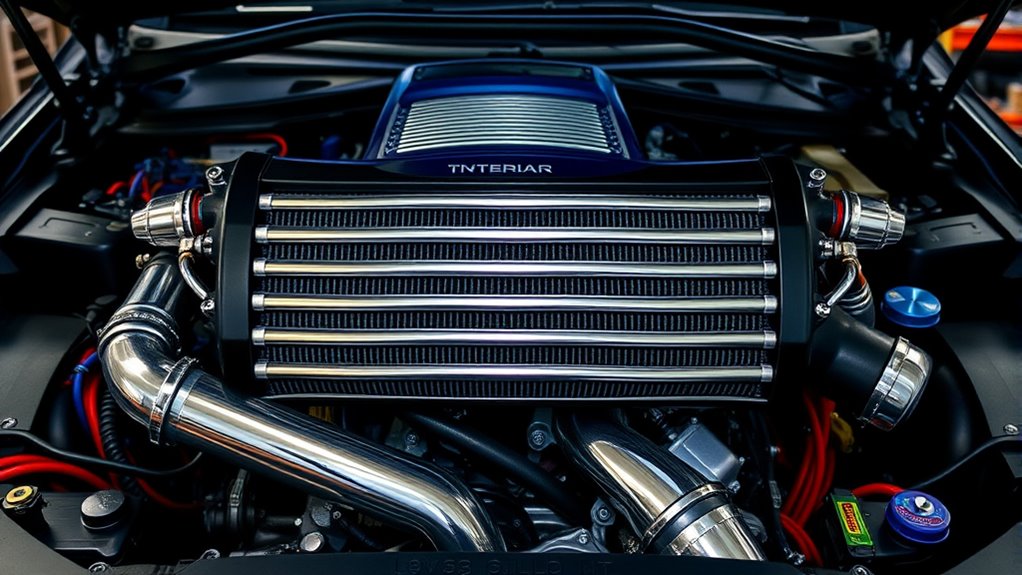
When selecting an intercooler for your setup, understanding the differences between the main types is key to making an informed choice. Air-to-air intercoolers are popular because they’re cost-effective and easy to install, relying on airflow to cool compressed air. They are the most common type used in production vehicles. In contrast, air-to-water intercoolers deliver superior cooling performance, but they’re more complex, requiring a separate cooling circuit, water pump, and additional plumbing. They tend to be heavier and more expensive to maintain. Your choice depends on your goals: if you want a simple, budget-friendly upgrade, go with an air-to-air intercooler. But if maximum cooling efficiency under high boost pressures is your priority, and you’re willing to handle added complexity and cost, an air-to-water system is the better option. Additionally, considering cooling capacity can help you determine which system will best meet your performance needs. For optimal performance, it’s also important to evaluate the thermal transfer efficiency of the intercooler to ensure it can handle your specific engine demands.
Key Factors to Consider When Selecting an Upgraded Intercooler

Choosing the right upgraded intercooler involves evaluating several key factors to guarantee it meets your performance goals and fits your vehicle. Material choice impacts durability, weight, and heat dissipation—aluminum offers affordability and good cooling, while stainless steel and carbon fiber provide increased strength and reduced weight at higher costs. Additionally, Ford tuning often includes intercooler upgrades that optimize charge air cooling for boosted engines. Size affects cooling efficiency, airflow, and boost pressure; larger cores improve performance but can pose fitment challenges. Design options like air-to-air or water-to-air influence installation complexity and cooling capacity. Compatibility is vital—use manufacturer charts or consider custom fabrication for unique setups. Furthermore, considering advanced cooling technologies can significantly enhance intercooler performance and longevity. Finally, balance performance gains with cost, installation effort, and maintenance needs to ensure your upgrade delivers the best value for your driving demands.
Benefits of Upgrading to a Front-Mount Intercooler
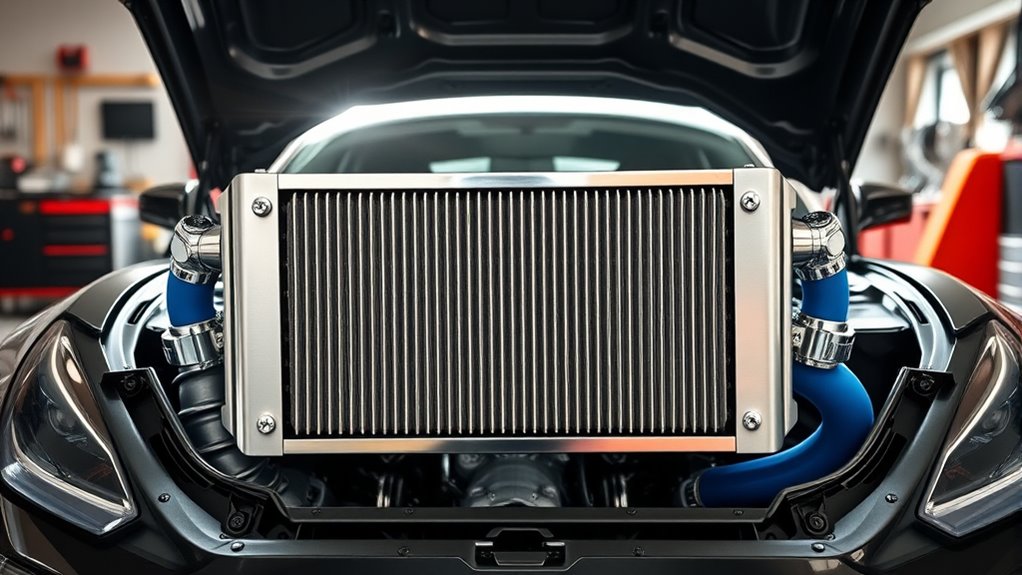
Ever wonder how upgrading to a front-mount intercooler can boost your vehicle’s performance? The main advantage is improved cooling efficiency. Its larger surface area and direct airflow access ensure consistent heat dissipation at all speeds.
This setup reduces heat soak compared to top-mount designs, keeping intake temps lower during heavy loads. Thicker cores and denser fins enhance thermal transfer, making cooling more effective.
The unobstructed airflow path maximizes ambient air contact, supporting higher volumetric airflow and better high-RPM performance. It also isolates the intake from engine heat, lowering underhood temperatures and protecting components.
This strategic placement improves heat management, maintains stable intake temps, and scales well with upgraded turbos and tuning. Overall, a front-mount intercooler delivers noticeable gains in power, responsiveness, and durability. FMICs can handle higher heat loads more effectively, making them especially suitable for high-performance applications.
How to Properly Install an Aftermarket Intercooler System

Installing an aftermarket intercooler system requires careful planning and precise execution to guarantee superior performance and reliability. First, review the installation guides thoroughly, following manufacturer instructions specific to your vehicle. Assess any existing modifications, like custom exhausts or tuning, that could affect the process. Gather all necessary tools and materials before starting to avoid interruptions.
Begin by removing the stock intercooler: disconnect air ducts, remove mounting hardware, and carefully extract the intercooler, inspecting the area for debris or damage. Next, position the new intercooler, ensuring proper alignment of inlet and outlet ports. Secure it with provided hardware, reconnect air ducts, and install intercooler piping, tightening clamps securely. Proper fitment is crucial, so take your time to ensure optimal placement.
The fitment process involves cutting and grinding edges to ensure proper placement of the intercooler. Ensure that all brackets and mounts are compatible and appropriately modified if necessary, to prevent misalignment or contact with other components. Checking for proper clearances during installation helps avoid future issues and maintains the integrity of your setup.
Finally, double-check all connections, perform a leak test, and ensure everything is properly reassembled before testing the system.
Enhancing Intercooler Performance With Custom Piping and Hardware
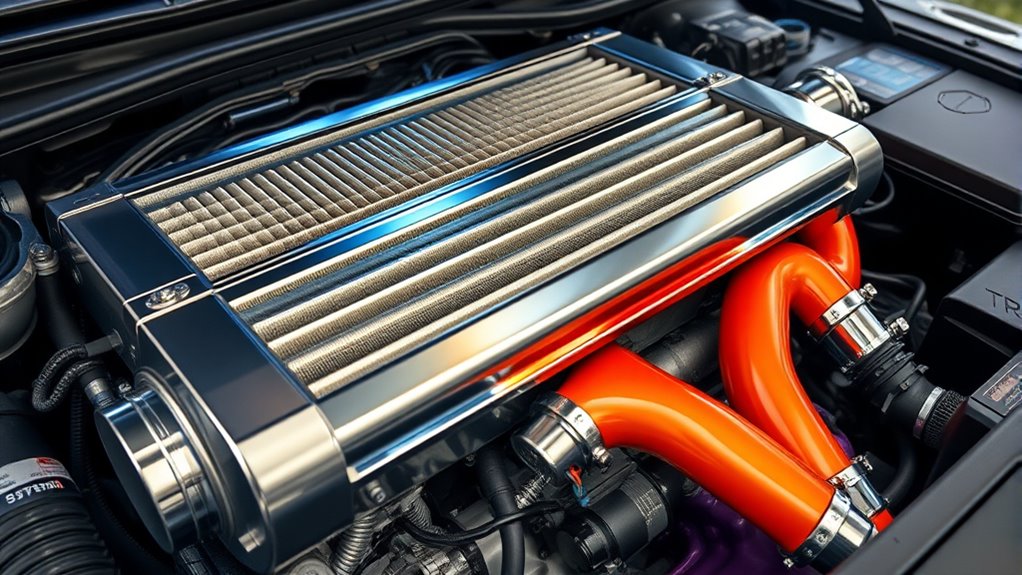
Enhancing your intercooler performance begins with selecting the right piping and hardware that optimize airflow and durability. Aluminum pipes are lightweight, dissipate heat well, and lower intake temperatures, while stainless steel offers strength and corrosion resistance, though it adds weight. Silicone hoses provide flexibility and thermal stability for smooth connections. Mandrel-bent pipes maintain consistent diameter and reduce turbulence, improving airflow. Proper insulation or coatings help prevent heat soak, keeping charge temperatures low. Incorporating remote hackathons can also facilitate collaboration with experts in intercooler technology and turbo system optimization. Additionally, understanding regional divorce statistics and legal resources can be beneficial when dealing with vehicle ownership transitions during your upgrades.
Monitoring and Optimizing Intake Air Temperatures Post-Upgrade

Monitoring and optimizing your intake air temperatures after upgrading your intercooler is vital for maintaining peak performance. Accurate readings help you assess intercooler efficiency and prevent thermal issues. Use intake temperature gauges to track air temps entering your engine, guaranteeing the system functions correctly and identifying unexpected spikes. Prices for gauges range from $109.99 to $199.99, making it accessible to many enthusiasts. Dual gauges can compare temperatures before and after the intercooler, providing a clearer picture of cooling performance. Proper sensor placement—on the charge pipe before the throttle body or after the intercooler outlet—is essential for accurate data. Regularly reviewing these readings enables you to fine-tune your setup, maintain cooler intake air, and maximize power. Ensuring your measurement tools are properly calibrated enhances data reliability, which is crucial for making informed adjustments. Check gauge range (0–300°F) for accuracy. Use dual monitors for thorough insights. Ensure sensors are correctly positioned. Regularly calibrate temperature sensors. Watch for unexpected temperature spikes.
Common Pitfalls to Avoid During Intercooler Upgrades

Upgrading your intercooler can considerably boost your vehicle’s performance, but overlooking common pitfalls can undermine your efforts. One major issue is heat management—excessive heat soak can cause power loss and increase detonation risk, while insufficient cooling leads to higher intake air temperatures. Intercoolers function similarly to radiators, extracting heat from compressed air to improve combustion and power output. Choosing an intercooler that’s too small or not properly tested afterward can result in poor performance. Environmental factors like ambient temperature also influence effectiveness.
Structurally, impact damage, bent fins, oil contamination, and leaks in hoses can reduce efficiency and cause damage. Proper airflow, clean fins, and intact seals are crucial for optimal heat exchange. Installation mistakes, such as incorrect fitment, poor support, neglecting boost hoses, and ignoring manufacturer instructions, often lead to leaks or damage. Ensuring correct mounting and secure connections helps maintain system integrity. Finally, skipped maintenance, like neglecting cleaning, inspections, or delaying leak repairs, can cause long-term issues that compromise your upgrade’s benefits. Regular checks and upkeep are essential to sustain improved performance over time.
Boosting Overall Vehicle Performance With Intercooler Improvements

Improving your intercooler can substantially boost your vehicle’s overall performance by effectively managing intake air temperatures and ensuring consistent power delivery. When you upgrade, you’ll benefit from lower intake air temps, which increase air density and enhance oxygen levels in the combustion chamber. This reduces engine knock, maintains stable combustion temperatures, and improves fuel efficiency by enabling more complete combustion.
Additionally, a better intercooler mitigates power loss caused by heat soak during sustained high loads, keeping your turbocharged system responsive. Intercooler upgrades significantly reduce Exhaust Gas Temperatures (EGTs), keeping them below 550-600°C, whereas stock EGTs can exceed 750°C, risking piston damage. Proper intercooling mitigates heat soak and hot engine component temperatures, prolonging engine reliability and performance.
- Larger core surface area enhances heat dissipation
- Bar-and-plate design outperforms tube-and-fin in thermal transfer
- Upgraded piping reduces turbulence and pressure drops
- Optimal mounting balances airflow access and protection
- High-flow end tanks maintain consistent charge air velocity
Tips for Maintaining and Troubleshooting Your Intercooler System
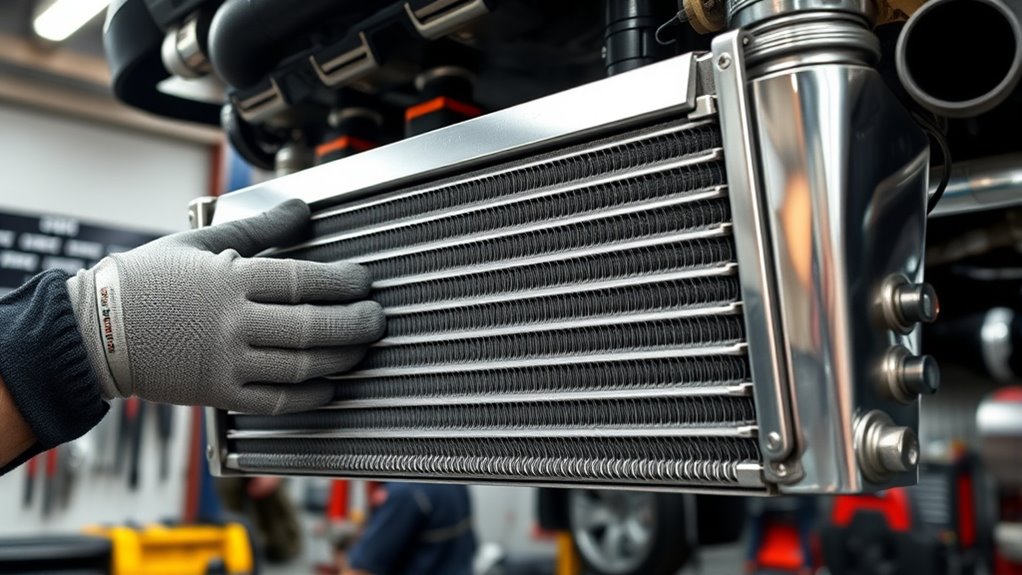
Regular maintenance is essential to keep your intercooler functioning efficiently and prevent unexpected breakdowns. You might need to remove it for thorough cleaning, which often involves taking off the front bumper or engine cover.
Use degreasers to prepare surfaces, then clean with acetone, kerosene, or methylated spirits until debris is fully removed. Rinse repeatedly until the cleaning agent runs clear. Applying degreasers helps break down stubborn oil and grime, making cleaning more effective. Allow the intercooler to dry completely before reinstalling to avoid moisture issues.
Regularly inspect for debris buildup, corrosion, leaks, and oil contamination. Address leaks immediately, and check hoses and connections for damage.
If performance drops or overheating occurs, clean or replace the intercooler as needed.
Conduct diagnostic tests to identify hidden issues and ensure your intercooler stays in top shape.
Frequently Asked Questions
How Much Does an Intercooler Upgrade Typically Cost?
An intercooler upgrade typically costs between $499.99 for basic kits and over $850 for high-performance models.
You might spend around $123.95 for entry-level options or up to $1,000 or more for custom or advanced aftermarket systems.
Remember, installation costs can add $302 to $443 if you hire a professional.
Your choice depends on your vehicle, desired performance, and budget.
Can I Install an Intercooler Without Professional Help?
You can install an intercooler yourself if you have basic mechanical skills and the right tools. Follow detailed, vehicle-specific guides, and make certain you have all necessary parts like hoses, clamps, and mounting hardware.
Be prepared for some fabrication or modifications, and take your time to avoid leaks or damage.
If you’re unsure at any step, consulting a professional can help prevent costly mistakes and guarantee peak performance.
What Are the Signs of a Failing or Inefficient Intercooler?
Think of your intercooler as the lungs of your engine—if it struggles, your car can’t breathe properly.
Signs of a failing intercooler include reduced power and sluggish acceleration, like running out of air. You might hear hissing or whistling sounds, indicating leaks.
Overheating, increased turbo noise, and poor fuel efficiency are also clues that your intercooler isn’t doing its job, and it’s time to get it checked.
How Do I Know if My Intercooler Is Properly Sized for My Engine?
You can tell if your intercooler is properly sized by checking if your engine stays cool under boost and maintains power without lag. Watch for consistent temperature drops during acceleration and minimal pressure loss in the intake system.
If your engine runs hotter or you notice performance dips, it might be undersized. Regularly monitor your boost pressure and intake temps to verify your intercooler matches your engine’s needs.
Will Upgrading My Intercooler Void My Vehicle’s Warranty?
Did you know that only 8% of warranty claims are denied due to aftermarket parts?
Upgrading your intercooler doesn’t automatically void your warranty, but it can affect coverage for specific components.
Dealers may decline service if they believe the upgrade caused issues, though laws like the Magnuson Moss Act require proof.
To avoid disputes, keep detailed records and check your manufacturer’s policy before making modifications.
Conclusion
Upgrading your intercooler isn’t just a mod; it’s the heartbeat of better performance. When you choose the right setup and maintain it properly, you release your car’s full potential—like opening a door to endless power. Remember, a cooler intake isn’t just a detail; it’s the difference between ordinary and extraordinary. Don’t settle for less—because your vehicle deserves to breathe easy and perform at its peak. The road to greatness starts with your intercooler upgrade.


